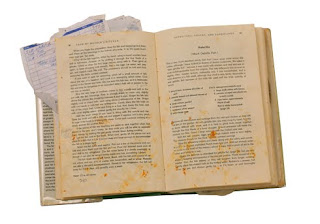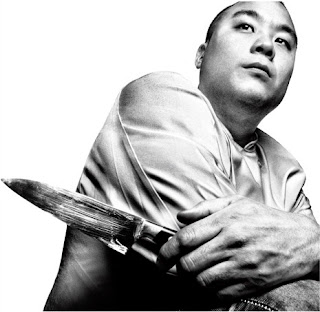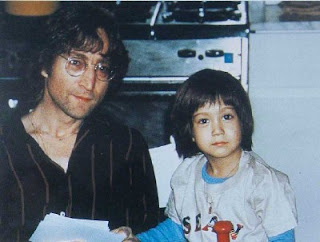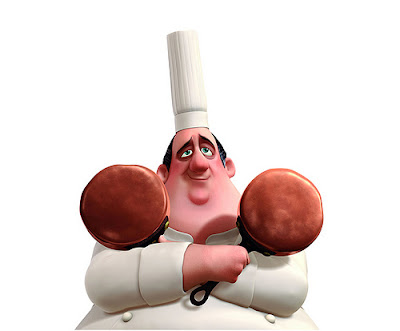 |
| Billy Taylor 1921-2010 |
Wednesday, December 29, 2010
Billy Taylor 1921-2010
Friday, December 17, 2010
F&C Rewind: The Perfect Chocolate Chip Cookie
Since it's cookie time, I thought I'd repeat a popular post from last year. Enjoy the cookies- they rock.
I am not a baker. Bakers are ultra-organized, super neat freaks and patient as Moses, as my grandmother used to say. Baking is methodical and consistent. And, contrary to the ongoing debate, it is an exact science. Yes, yeasts and leaveners do have their own ideas about how and when they'll work, if at all. But, the learned baker keeps this and any other factors under control by observation and accounts for any rogue ingredients. A great baker doesn't get any "surprises". And, for what it's worth, the most talented bakers I know are either Virgos or Geminis. *Just sayin'*
Yet, for all that apparent rigidity and discipline, there is something very calming and therapeutic about baking. If you're in the kitchen all day with your onions, garlic and other non-pastry ingredients, the chance to cook outside the box is a welcomed and delightful change. It's like picking up a guitar; each time you play, it's always fun. You pick up where you left off, tinker here and there. And, the more you play, each time you learn a little more, and before you know it, you've got a list of songs you're good at. That's baking, in a pie shell.
Just the sheer aromatherapy of baking can transform you. I realize I'm preaching to the choir here; I mean, who doesn't swoon over smells of caramelizing sugar, fresh vanilla, warm chocolate, cinnamon and butter? Baking is a treat for all the senses. For me, the less gadgets, the better. I want to get my hands dirty. Give me a good set of mixing bowls, a killer scale and durable measuring cups and spoons, a Kitchen Aid, a sil-pat, great pans- and I'm good, yo.
The second tenet of successful baking, after good equipment, is great ingredients. Use good butter. Please. Know which flour a recipe calls for- and get it. Farm fresh eggs are always going to be better than supermarket. Period. I could write a whole post on vanilla- just know that all vanilla is NOT created equal. Cream and milk? Fat is important. And a little known fact, cream that is out of "date", is actually better for baking (It whips up faster). Use fruits that are in season. And finally, there is a reason why there are hundreds of types of chocolate. Read a little about chocolate and educate yourself.
I'm not talking just sweet baking, either. Bread baking can soothe the savage beast. Kneading dough with the sleeves rolled up is like a good workout. And, the toasty, yeasty aromas that emanate from your oven on a Sunday morning or winter's afternoon can transform the moodiest, crankiest cook into the most blissed out baker.
If there is one thing that baking has taught me, it's the importance of method, method, method. If you follow a well-written recipe to the letter, you're gonna rock the house every time. I think one of the reasons people fail when baking is because a recipe is too vague. For example, the #1 reason cookies turn out flat and not fluffy is because people skip the step of chilling the cookie dough before baking. It's like we can't wait another blessed second to get a steaming, gooey chocolate chip cookie off the sheet and into our mouth; if the recipe or chef explained why it's so crucial, we'd never skip the chilling process again.
The liquifiers, other wise known as eggs and butter, require congealing with the other ingredients, the stabilizers. When that little dab of dough hits the oven, the first thing to happen is the steaming of the butter and eggs. If the dough is too warm, they go flat- instantly. The colder it is, the longer it takes to liquify the eggs and butter, thereby allowing the cookie to retain its desired lumpy, chunky shape. The steam released from the butter causes the dough to rise, aided by the eggs, and in just a short 9-14 minutes, depending on the recipe, you've got an enviable cookie.
Don't stop there. Follow that recipe! When it says "cream the butter and sugar", know what you're doing and why. By combining the two until they are one isn't enough. You're incorporating volume that is equally crucial to the height of a killer cookie. I've seen cookie recipes that call for using a paddle on the mixer, and some that call for the whip. At this point, it's up to you. Do you want a dense cookie, or a light, fluffy one? This is the difference. How about a c.c. cookie recipe that calls for all brown sugar? Again, different sugars behave differently; brown sugar has moisture- whip it into butter and you're trapping air- which will work to your advantage for a fluffy cookie. Double the amount of vanilla and your cookie tastes just a little more decadent than the ordinary. Mix the chips (the last step) until just incorporated so you aren't activating the gluten in the flour further, and your "crumb" is larger. "Overmix" and you have a chewier cookie. Old baking soda? Not nearly as effective as new. Or, sift your flour, and your cookie is fluffier. Do you see the numerous factors that contribute to the outcome of your cookie? Yet, no one exlpains why.
These are concepts. Once you've experimented with them and ultimately obey them, they apply to all of cooking and baking.
Freeze your tart shell like your cookie dough for a flakier crust. Experiment with fat- do I use lard or butter? Shortening or a combination? Play with it until you find a recipe you really dig. Experiment with moisture in your oven when baking bread. Own a convection oven? Whoa! That's a whole other post, Bubbalouie! But, know that heat source is a HUGE determining factor in the outcome of a baking product.
And so, as is common, my foodie nerd side gets carried away, and I approach a TMI phase. If you follow this blog, you'll know that a common theme is "concepts and fundamentals". Once you've grasped them, you have more control over what you're cooking. No one is trying to make a scientist out of you, but when some of these tidbits are taken into consideration, it may help demystify cooking. And that alone is worth the virtual paper this is written on.
The following is a straight-off-the-wrapper recipe for Nestle Toll House Chocolate Chip Cookies. And it happens to be the only one I use.
2 1/4 cups all-purpose flour
1 teaspoon baking soda
1 teaspoon salt
1 cup (2 sticks) butter, softened
3/4 cup granulated sugar
3/4 cup packed light brown sugar
1 teaspoon vanilla extract
2 large eggs
2 cups (12 oz. pkg.) Nestle Toll House Semi-Sweet Morsels
1 cup chopped nuts
COMBINE flour, baking soda and salt in small bowl. Beat butter, granulated sugar, brown sugar and vanilla extract in large mixer bowl until creamy. Add eggs, one at a time, beating well after each addition. Gradually beat in flour mixture. Stir in morsels and nuts. Chill batter until firm, about 45 minutes. Drop by rounded tablespoon onto ungreased baking sheets.
BAKE for 9 to 11 minutes or until golden brown. Cool on baking sheets for 2 minutes; remove to wire racks to cool completely.
Yet, for all that apparent rigidity and discipline, there is something very calming and therapeutic about baking. If you're in the kitchen all day with your onions, garlic and other non-pastry ingredients, the chance to cook outside the box is a welcomed and delightful change. It's like picking up a guitar; each time you play, it's always fun. You pick up where you left off, tinker here and there. And, the more you play, each time you learn a little more, and before you know it, you've got a list of songs you're good at. That's baking, in a pie shell.
Just the sheer aromatherapy of baking can transform you. I realize I'm preaching to the choir here; I mean, who doesn't swoon over smells of caramelizing sugar, fresh vanilla, warm chocolate, cinnamon and butter? Baking is a treat for all the senses. For me, the less gadgets, the better. I want to get my hands dirty. Give me a good set of mixing bowls, a killer scale and durable measuring cups and spoons, a Kitchen Aid, a sil-pat, great pans- and I'm good, yo.
The second tenet of successful baking, after good equipment, is great ingredients. Use good butter. Please. Know which flour a recipe calls for- and get it. Farm fresh eggs are always going to be better than supermarket. Period. I could write a whole post on vanilla- just know that all vanilla is NOT created equal. Cream and milk? Fat is important. And a little known fact, cream that is out of "date", is actually better for baking (It whips up faster). Use fruits that are in season. And finally, there is a reason why there are hundreds of types of chocolate. Read a little about chocolate and educate yourself.
I'm not talking just sweet baking, either. Bread baking can soothe the savage beast. Kneading dough with the sleeves rolled up is like a good workout. And, the toasty, yeasty aromas that emanate from your oven on a Sunday morning or winter's afternoon can transform the moodiest, crankiest cook into the most blissed out baker.
If there is one thing that baking has taught me, it's the importance of method, method, method. If you follow a well-written recipe to the letter, you're gonna rock the house every time. I think one of the reasons people fail when baking is because a recipe is too vague. For example, the #1 reason cookies turn out flat and not fluffy is because people skip the step of chilling the cookie dough before baking. It's like we can't wait another blessed second to get a steaming, gooey chocolate chip cookie off the sheet and into our mouth; if the recipe or chef explained why it's so crucial, we'd never skip the chilling process again.
The liquifiers, other wise known as eggs and butter, require congealing with the other ingredients, the stabilizers. When that little dab of dough hits the oven, the first thing to happen is the steaming of the butter and eggs. If the dough is too warm, they go flat- instantly. The colder it is, the longer it takes to liquify the eggs and butter, thereby allowing the cookie to retain its desired lumpy, chunky shape. The steam released from the butter causes the dough to rise, aided by the eggs, and in just a short 9-14 minutes, depending on the recipe, you've got an enviable cookie.
Don't stop there. Follow that recipe! When it says "cream the butter and sugar", know what you're doing and why. By combining the two until they are one isn't enough. You're incorporating volume that is equally crucial to the height of a killer cookie. I've seen cookie recipes that call for using a paddle on the mixer, and some that call for the whip. At this point, it's up to you. Do you want a dense cookie, or a light, fluffy one? This is the difference. How about a c.c. cookie recipe that calls for all brown sugar? Again, different sugars behave differently; brown sugar has moisture- whip it into butter and you're trapping air- which will work to your advantage for a fluffy cookie. Double the amount of vanilla and your cookie tastes just a little more decadent than the ordinary. Mix the chips (the last step) until just incorporated so you aren't activating the gluten in the flour further, and your "crumb" is larger. "Overmix" and you have a chewier cookie. Old baking soda? Not nearly as effective as new. Or, sift your flour, and your cookie is fluffier. Do you see the numerous factors that contribute to the outcome of your cookie? Yet, no one exlpains why.
These are concepts. Once you've experimented with them and ultimately obey them, they apply to all of cooking and baking.
Freeze your tart shell like your cookie dough for a flakier crust. Experiment with fat- do I use lard or butter? Shortening or a combination? Play with it until you find a recipe you really dig. Experiment with moisture in your oven when baking bread. Own a convection oven? Whoa! That's a whole other post, Bubbalouie! But, know that heat source is a HUGE determining factor in the outcome of a baking product.
And so, as is common, my foodie nerd side gets carried away, and I approach a TMI phase. If you follow this blog, you'll know that a common theme is "concepts and fundamentals". Once you've grasped them, you have more control over what you're cooking. No one is trying to make a scientist out of you, but when some of these tidbits are taken into consideration, it may help demystify cooking. And that alone is worth the virtual paper this is written on.
The following is a straight-off-the-wrapper recipe for Nestle Toll House Chocolate Chip Cookies. And it happens to be the only one I use.
Directions
PREHEAT oven to 375° F.COMBINE flour, baking soda and salt in small bowl. Beat butter, granulated sugar, brown sugar and vanilla extract in large mixer bowl until creamy. Add eggs, one at a time, beating well after each addition. Gradually beat in flour mixture. Stir in morsels and nuts. Chill batter until firm, about 45 minutes. Drop by rounded tablespoon onto ungreased baking sheets.
BAKE for 9 to 11 minutes or until golden brown. Cool on baking sheets for 2 minutes; remove to wire racks to cool completely.
Tuesday, December 14, 2010
Chef Quote of the Week: David Chang
"I think the basic thing that home cooks can learn how to do is just season properly. ... If the home cook realized how little salt they use compared to what's needed, it would make their food taste better."
David Chang
Momofuku Noodle Bar, Ko, Milk Bar and Ma Peche
Monday, December 13, 2010
Your Mother Should Know: A Culinary Top 10 List
When learning to cook, the "aha!" moments are rare. But they do exist, and my friends, I'm here to tell you: listen to them.
As I find myself well into the educational phase of my career (that is, passing on what I know to other cooks), I'm discovering that for every moment the world of cooking seemed like an endless expanse of culinary universe, I find that universe shrinking and starting to make more sense each day.
What some sources refer to as the culinary basics, our mothers and grandmothers would call good, common sense. Let's face it; in the realm of chicken and egg scenarios, it's the all-knowing, multi-tasking matron of the hearth who came long before the Certified Master Chef. For all those women who had no choice but to cook for their families when the house was empty of kids or working men, they did so out of necessity and survival, not expression of creativity or ego. Before cookbooks and anything slightly resembling a home-guide for the kitchen were available, determining which pot was best for which dish, when a using a wooden spoon was better than a metal one, when to cover the pot, or leave it open- and when to turn the flame up versus down was trial by fire (pun-intended).
It wasn't until the supposed "masters" like Escoffier and Careme, Brillat-Savarin and other culinary giants came along with their guides and rules for doing it right all the time. Most of these men served careers in the military first. Upon leaving the service, they applied this new-found rigidity and culture of order to the craft of cooking, and in doing so, they turned it into a science. They evaluated things like boiling points of water vs. sugar, they studied the effects of heat and steam on proteins and the differences of various cooking metals (i.e. copper versus aluminum). They wrote the recipes for the basics, and, in short, they codified cooking to remove the guess work and make it a more exact science.
"So", you say, "my grandmother couldn't tell you the exact poaching temperature for a terrine, but I'm certain she has one of the most bad-ass pie crusts you'll ever make!" And, you're right. Ironically, it's the simplest of elements the housewife mastered in cooking that young line cooks and culinary students today can't grasp. I think most cooks think not about putting the final product on a table to actually savor, eat and enjoy, but more about how it will look on the plate. Taste has become secondary. Tsk, tsk, tsk.
More mothers and grandmothers have landed perfect pot roasts and mashed potatoes on kitchen tables they knew tasted good than can most line cooks today, I can tell you. One factor is the incessant distractions for line cooks. They fight boredom, extreme temperatures, long-hours, sleep deprivation, substance abuse, hangovers, ADHD and the insidious Top Chef scenarios which play out in their heads. If only I were competing, I'd show them all! Well, if competing on a cooking show is anything like taking your cooking practical at culinary school where you are judged on technique, creativity, mastery of basics and timing, let's just say that having a camera shoved in your arse won't make it any easier (certainly not on your ego when you're trashed by the judges in front of millions).
Upon graduating from CIA, I landed as a sous chef for my first cooking job. Heading up my first kitchen, I had set a standard for myself: never, EVER, let a dish go out of the kitchen that I wouldn't be proud to serve my parents or my instructors at school. It worked for me. But, line cooks also notoriously have a varying degree of quality acceptance in their heads which could be set very high one day, and very low the next, often depending on the factors mentioned above. To fight that rogue thinking in cooks, I employed a mantra of thinking "ALWAYS". "Always" was the sure-fire way to infiltrate the cob-webby minds of cooks to make sure that whenever considering cutting a corner, taking that shortcut or battling laziness, they would prevail by choosing the one correct route: the right way, always.
And so, this brings us back to why mothers and grandmothers have always had the upper hand on so many aspiring iron chefs, career line-cooks, hot-shot culinary snots and gadget toting food geeks; they learned by trial and error, not from books, a sous chef or even television.
Here then, in no particular order, whether you cook at home, as a hobby or on the chain gang somewhere in the masses of mashed potato houses, are my
1. Control Your Heat- Oh, how I've watched a poor dish of veal medallions languishing in a saute pan that isn't hot enough, or a cream sauce on nuclear boil. A stove has knobs; USE THEM!
2. Work Clean- ALWAYS clean after yourself as you go. It is the key to organization mastery. A dirty cutting board is a dirty mind.
3. Be Patient- You can make something fast, or you can make it the right way. Cut corners and you cheat flavor.
4. Taste and Season Often- If you aren't tasting what you're cooking, you are not a real cook, but a robot. Enjoy your life of automated servitude. Or, season and taste your food and build a library of flavors, sensations and a vocabulary that will help you get the most enjoyment out of the culinary arts.
5. Listen- Your food is talking to you. Very often it can tell you that you're doing something wrong, like cooking on too high heat or not enough oil in your pan. Food that snaps, slides, pops and sighs is teaching you about cooking. Listen to it.
6. Smell- Your sense of smell can save you from using fish that is past "safe" or knowing the difference from toasted bread and charcoal. A simple pot of tomato sauce has that "finished" smell when the combination of onion, garlic, tomato and herbs have melded into one harmonious, heady aroma.
7. Use Fresh- If you are ever asking which is the better ingredient(s) to use, the answer will 99.9% of the time be "fresh". Think about it. If taste is priority (and I think we've established it should be), then use fresh products. If you want to cut corners and make a quick stew our soup, use your canned beans, dried herbs and bouillon cubes. If you want to see the difference I'm talking about, try it the other way.
8. Order of Ingredients- There is ALWAYS a right order to put ingredients in a recipe for maximum flavor and/or correctness. And you need to learn why. Sometimes it's scientific, other times it's common sense. A fresh pea takes, what- two minutes to cook? Add it at the beginning of a 45 minute soup, stew or saute and you've killed any flavor, nutritional value or color that poor legume ever had of gifting you.
9. Use Proper Tools and Sharp Knives- You've heard this one a lot. So why do you insist on using tongs for every task, you filthy, dirty little cook, you? There is a big difference between gadgets and proper kitchen tools, particularly spatulas. Same goes for bowls, pots and pans. Stop being lazy. Also, sharp knives are better and safer to work with, always. But, if you insist, go ahead and cut your fingers off. You're giving the rest of us a bad name.
UPDATE: Case in point- this article in the WSJ one day later...
10. Know When to Stop- There is always a time when you should stop; stop beating, stop blending, roasting, adding salt, adding other ingredients or just trying. Read your recipes and listen (ahem) to what they say. This one can't be taught, so you just have to learn it. Or, go ask your grandmother.
As I find myself well into the educational phase of my career (that is, passing on what I know to other cooks), I'm discovering that for every moment the world of cooking seemed like an endless expanse of culinary universe, I find that universe shrinking and starting to make more sense each day.
What some sources refer to as the culinary basics, our mothers and grandmothers would call good, common sense. Let's face it; in the realm of chicken and egg scenarios, it's the all-knowing, multi-tasking matron of the hearth who came long before the Certified Master Chef. For all those women who had no choice but to cook for their families when the house was empty of kids or working men, they did so out of necessity and survival, not expression of creativity or ego. Before cookbooks and anything slightly resembling a home-guide for the kitchen were available, determining which pot was best for which dish, when a using a wooden spoon was better than a metal one, when to cover the pot, or leave it open- and when to turn the flame up versus down was trial by fire (pun-intended).
It wasn't until the supposed "masters" like Escoffier and Careme, Brillat-Savarin and other culinary giants came along with their guides and rules for doing it right all the time. Most of these men served careers in the military first. Upon leaving the service, they applied this new-found rigidity and culture of order to the craft of cooking, and in doing so, they turned it into a science. They evaluated things like boiling points of water vs. sugar, they studied the effects of heat and steam on proteins and the differences of various cooking metals (i.e. copper versus aluminum). They wrote the recipes for the basics, and, in short, they codified cooking to remove the guess work and make it a more exact science.
"So", you say, "my grandmother couldn't tell you the exact poaching temperature for a terrine, but I'm certain she has one of the most bad-ass pie crusts you'll ever make!" And, you're right. Ironically, it's the simplest of elements the housewife mastered in cooking that young line cooks and culinary students today can't grasp. I think most cooks think not about putting the final product on a table to actually savor, eat and enjoy, but more about how it will look on the plate. Taste has become secondary. Tsk, tsk, tsk.
More mothers and grandmothers have landed perfect pot roasts and mashed potatoes on kitchen tables they knew tasted good than can most line cooks today, I can tell you. One factor is the incessant distractions for line cooks. They fight boredom, extreme temperatures, long-hours, sleep deprivation, substance abuse, hangovers, ADHD and the insidious Top Chef scenarios which play out in their heads. If only I were competing, I'd show them all! Well, if competing on a cooking show is anything like taking your cooking practical at culinary school where you are judged on technique, creativity, mastery of basics and timing, let's just say that having a camera shoved in your arse won't make it any easier (certainly not on your ego when you're trashed by the judges in front of millions).
Upon graduating from CIA, I landed as a sous chef for my first cooking job. Heading up my first kitchen, I had set a standard for myself: never, EVER, let a dish go out of the kitchen that I wouldn't be proud to serve my parents or my instructors at school. It worked for me. But, line cooks also notoriously have a varying degree of quality acceptance in their heads which could be set very high one day, and very low the next, often depending on the factors mentioned above. To fight that rogue thinking in cooks, I employed a mantra of thinking "ALWAYS". "Always" was the sure-fire way to infiltrate the cob-webby minds of cooks to make sure that whenever considering cutting a corner, taking that shortcut or battling laziness, they would prevail by choosing the one correct route: the right way, always.
And so, this brings us back to why mothers and grandmothers have always had the upper hand on so many aspiring iron chefs, career line-cooks, hot-shot culinary snots and gadget toting food geeks; they learned by trial and error, not from books, a sous chef or even television.
Here then, in no particular order, whether you cook at home, as a hobby or on the chain gang somewhere in the masses of mashed potato houses, are my
Top 10 Things You Can Do to Be a Better Cook:
1. Control Your Heat- Oh, how I've watched a poor dish of veal medallions languishing in a saute pan that isn't hot enough, or a cream sauce on nuclear boil. A stove has knobs; USE THEM!
2. Work Clean- ALWAYS clean after yourself as you go. It is the key to organization mastery. A dirty cutting board is a dirty mind.
3. Be Patient- You can make something fast, or you can make it the right way. Cut corners and you cheat flavor.
4. Taste and Season Often- If you aren't tasting what you're cooking, you are not a real cook, but a robot. Enjoy your life of automated servitude. Or, season and taste your food and build a library of flavors, sensations and a vocabulary that will help you get the most enjoyment out of the culinary arts.
5. Listen- Your food is talking to you. Very often it can tell you that you're doing something wrong, like cooking on too high heat or not enough oil in your pan. Food that snaps, slides, pops and sighs is teaching you about cooking. Listen to it.
6. Smell- Your sense of smell can save you from using fish that is past "safe" or knowing the difference from toasted bread and charcoal. A simple pot of tomato sauce has that "finished" smell when the combination of onion, garlic, tomato and herbs have melded into one harmonious, heady aroma.
7. Use Fresh- If you are ever asking which is the better ingredient(s) to use, the answer will 99.9% of the time be "fresh". Think about it. If taste is priority (and I think we've established it should be), then use fresh products. If you want to cut corners and make a quick stew our soup, use your canned beans, dried herbs and bouillon cubes. If you want to see the difference I'm talking about, try it the other way.
8. Order of Ingredients- There is ALWAYS a right order to put ingredients in a recipe for maximum flavor and/or correctness. And you need to learn why. Sometimes it's scientific, other times it's common sense. A fresh pea takes, what- two minutes to cook? Add it at the beginning of a 45 minute soup, stew or saute and you've killed any flavor, nutritional value or color that poor legume ever had of gifting you.
9. Use Proper Tools and Sharp Knives- You've heard this one a lot. So why do you insist on using tongs for every task, you filthy, dirty little cook, you? There is a big difference between gadgets and proper kitchen tools, particularly spatulas. Same goes for bowls, pots and pans. Stop being lazy. Also, sharp knives are better and safer to work with, always. But, if you insist, go ahead and cut your fingers off. You're giving the rest of us a bad name.
UPDATE: Case in point- this article in the WSJ one day later...
10. Know When to Stop- There is always a time when you should stop; stop beating, stop blending, roasting, adding salt, adding other ingredients or just trying. Read your recipes and listen (ahem) to what they say. This one can't be taught, so you just have to learn it. Or, go ask your grandmother.
Wednesday, December 8, 2010
John Lennon: Oct. 9, 1940- Dec. 8, 1980
"Life is what happens to you while you're busy making other plans."
Never are we reminded more of the preciousness of life as when someone special in our lives is taken from us suddenly. I was 14 in 1980 when I heard John Lennon had been shot and killed. I didn't know much about his life after The Beatles, accept that he was still alive and lived with Yoko Ono in a place called The Dakota. That confused the hell out of me, since I heard he lived in New York.
As a musician, I was really into The Beatles as a kid. My parents had their albums, and they always seemed to be on the radio. When some of the girls in my class wept that he had been killed, I didn't understand what for. It actually seemed a bit contrived, too. They painted peace symbols in eyebrow pencil on their cheeks and temporary tears at the corners of their eyes to show their permanent sadness. "The world suffered a big loss for Peace today", one said. Still, I didn't get it. Idolatry was too big a word for me to use back then, but I understood its usage. Did they understand that?
What I did get, however, was the huge musical loss we had just been dealt. If ever there was to be a chance that The Beatles would reunite to play a concert, release a new album or even go back on tour, it was certainly most permanent now. And that struck a strong emotion in me: despair. What could be or could have been. Missed opportunities and potential represent some of the saddest of life's realities.
As I grew older, I began to learn more about my new hero. I learned which Beatles lyrics were his- and it made sense. He was at once sarcastic and satirical, roguish and romantic. I learned about his activism and ornery side, too. I read books about him and his children. I even understood Yoko, his much maligned widow who still evokes a great hatred among people that is at best irrational, and at worst the opposite of what John Lennon was about.
He made me laugh, too. Like in a scene from Hard Day's Night, while the band is goofing off, he is seen quietly, yet curiously, holding a bottle of Coke up to his nose and snorting. Subtle was John's forte. In today's New York Times, Yoko Ono tells a story about how she and John used to laugh together. And, one of her best and favorite memories of John was when they would make tea together. Despite the myriad emotions we feel when we lose someone dear, the best way to overcome the grief and appreciate our time with them is with laughter.
For me, however, it will always be the music of John Lennon and The Beatles that bring the fondest memories; and for my daughter, they're the kind I can pass on.
Monday, December 6, 2010
Silver and Gold? COPPER!
Another holiday season upon us, and another year we revisit all the classic Christmas tunes that sing the praises of silver and gold. Yes- precious metals lovely to look at and make that tree shine- but, none give the love that French copper gives a cook. Glorious, gleaming, heavy-duty copper sauteuses and sautoirs, roasters and rondeaus, round paella and oval Dutch ovens, and the precious 1/4 quart cocotte for the escargots lover. They give the feeling of preparing a meal for royalty. The touch of one in your hand is like holding a precious stringed instrument or rare bottle of wine. When I wash mine, I'm reminded of how I used to bathe my infant daughter in the sink, with warm water, gentle soap and a loving, fatherly caress. Patted down gently with fine cotton cloth, of course. And, if you look closely on the handle, you'll notice a set of lip prints where I lovingly bid "good night" to it.
GEEK!!
Truly, though- each year here in Delaware, we're treated to a rare event- the happenstance of residing in the state that is home to the U.S. warehouse of French imported Mauviel Copper Pots and Pans, along with Emile-Henry cookware, Rősle stainless steel utensils, Cuisipro multi-purpose kitchen gadgets and other high-quality brands of kitchen helpers. The event is a two-day warehouse sale that is open to the public and offers them the chance to purchase all that these companies stock at up to 80% off the retail price. Deck the Halls, indeed.
Subscribe to:
Comments (Atom)















